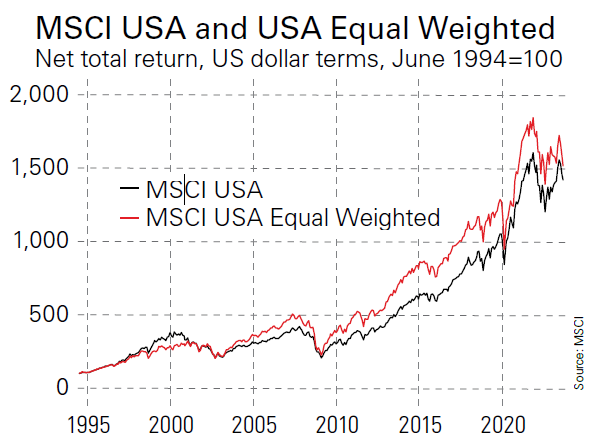Get back in balance with equal-weighted indices
Equal-weighted indices are one way to dilute the influence of mega-cap tech stocks in the US market.


Top-down investors who worry about how much the top seven tech stocks now dominate the US market have two obvious choices.
The first is to avoid US stocks altogether. That may make sense tactically – for example, if you think that the gap between European and US stocks will narrow in the near term. However, for a longer-term asset allocation, it’s a very big decision to hold nothing in a country that accounts for about a quarter of the global economy, has the best record on economic growth and innovation, and shows a long history of delivering superior returns. Realistically, not many global investors are going to do that.
So the alternative is to use alternative weighting schemes – i.e., setting the proportion of each stock in your portfolio according to criteria other than market capitalisation. The simplest of these is equal weighting, where each company accounts for the same share of the index at the start, and is rebalanced back to equal weights at regular intervals (typically quarterly).
MoneyWeek
Subscribe to MoneyWeek today and get your first six magazine issues absolutely FREE

Sign up to Money Morning
Don't miss the latest investment and personal finances news, market analysis, plus money-saving tips with our free twice-daily newsletter
Don't miss the latest investment and personal finances news, market analysis, plus money-saving tips with our free twice-daily newsletter

A tough decade for equal weighting
Over the very long term, equal weighting has tended to beat cap weighting, because it holds more in value shares and in smaller stocks – both of which have outperformed in the past. The last decade has not been kind to it – the big tech giants have kept outstripping the market and growing in influence and equal weighting has leaned against that. However, despite that, the MSCI USA Equal Weighted Index is still slightly ahead of the MSCI USA since 1994 (9.71% per year versus 9.45%), even after lagging by almost 3.5 percentage points per year over the past five years.
Index returns don’t always match well with what investors earn, due to trading fees, spreads and taxes, and equal weighting has a much higher turnover than cap weighting. So we need to see if products are able to track the benchmark closely.
The main option for UK investors is the Xtrackers S&P 500 Equal Weight (LSE: XDWE), whose annualised return over five years is 9.83% per year compared to a benchmark of 9.78% – ie, a very close tracking difference. Investors who want to favour US tech yet underweight the giants could consider the Invesco NASDAQ-100 Equal Weight ETF (LSE: EWQX), but this is a new fund and so we can’t check the tracking history (although there’s no obvious reason why it should be worse).
So should we employ an equal-weight fund for the US in our asset allocation strategy? There’s one argument against it: our portfolio is already weighted towards markets that we think offer greater value (Japan, emerging markets, Europe). Keeping a mega-cap tech bias in the S&P 500 may help balance our value approach against the tail risk that these firms keep growing to dominate the world economy due to breakthroughs in fields such as artificial intelligence. Set against that, valuations for big tech look stretched and history implies equal weighting may work well from here. So this is an option we’ll consider carefully once we’ve reviewed the rest of our positions.
This article was first published in MoneyWeek's magazine and all information was correct at the time of writing. Enjoy exclusive early access to news, opinion and analysis from our team of financial experts with a MoneyWeek subscription.
Related articles
- 5 top UK tech stocks
- 5 top tech stocks to boost your investment portfolio
- How to find the market’s “multi-bagger” stocks
Get the latest financial news, insights and expert analysis from our award-winning MoneyWeek team, to help you understand what really matters when it comes to your finances.
Cris Sholto Heaton is an investment analyst and writer who has been contributing to MoneyWeek since 2006 and was managing editor of the magazine between 2016 and 2018. He is especially interested in international investing, believing many investors still focus too much on their home markets and that it pays to take advantage of all the opportunities the world offers. He often writes about Asian equities, international income and global asset allocation.
Cris began his career in financial services consultancy at PwC and Lane Clark & Peacock, before an abrupt change of direction into oil, gas and energy at Petroleum Economist and Platts and subsequently into investment research and writing. In addition to his articles for MoneyWeek, he also works with a number of asset managers, consultancies and financial information providers.
He holds the Chartered Financial Analyst designation and the Investment Management Certificate, as well as degrees in finance and mathematics. He has also studied acting, film-making and photography, and strongly suspects that an awareness of what makes a compelling story is just as important for understanding markets as any amount of qualifications.
-
 The most influential people of 2025
The most influential people of 2025Here are the most influential people of 2025, from New York's mayor-elect Zohran Mamdani to Japan’s Iron Lady Sanae Takaichi
-
 Millions of parents are missing out on up to £720 a year in extra pension cash – are you affected?
Millions of parents are missing out on up to £720 a year in extra pension cash – are you affected?A mum who narrowly missed out on the pension boost said she “never knew the government rule existed” and wants other parents to use it
-
 8 of the best properties for sale with indoor gyms
8 of the best properties for sale with indoor gymsThe best properties for sale with indoor gyms – from a four-storey mews house in London’s Knightsbridge, to a 1920s Arts & Crafts house in Melbury Abbas, Dorset
-
 Top stock ideas for 2026 that offer solidity and growth
Top stock ideas for 2026 that offer solidity and growthLast year’s stock ideas from MoneyWeek’s columnist and trader, Michael Taylor, produced another strong performance. This year’s stocks look promising too
-
 Market predictions for 2026: Will Dubai introduce an income tax?
Market predictions for 2026: Will Dubai introduce an income tax?Opinion My 2026 predictions, from a supermarket merger to Dubai introducing an income tax and Britain’s journey back to the 1970s
-
 Stock markets have a mountain to climb: opt for resilience, growth and value
Stock markets have a mountain to climb: opt for resilience, growth and valueOpinion Julian Wheeler, partner and US equity specialist, Shard Capital, highlights three US stocks where he would put his money
-
 The steady rise of stablecoins
The steady rise of stablecoinsInnovations in cryptocurrency have created stablecoins, a new form of money. Trump is an enthusiastic supporter, but its benefits are not yet clear
-
 SRT Marine Systems: A leader in marine technology
SRT Marine Systems: A leader in marine technologySRT Marine Systems is thriving and has a bulging order book, says Dr Michael Tubbs
-
 Goodwin: A superlative British manufacturer to buy now
Goodwin: A superlative British manufacturer to buy nowVeteran engineering group Goodwin has created a new profit engine. But following its tremendous run, can investors still afford the shares?
-
 A change in leadership: Is US stock market exceptionalism over?
A change in leadership: Is US stock market exceptionalism over?US stocks trailed the rest of the world in 2025. Is this a sign that a long-overdue shift is underway?
